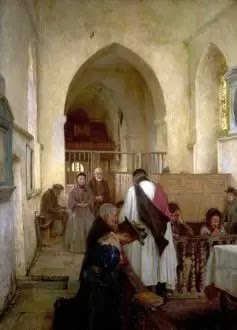The Barchester Option: Old High, New Low
If you're in the United States you're probably the most likely to emphasize that you're part of the PROTESTANT Episcopal Church in the United States of America and you still refer to the 1979 BCP as the "New Prayer book" regardless of how old you are. And yes you probably would like an American Flag hanging behind the altar, all things considered. If you're in Britain you're the early service 1662 spoken service type. You have a strong sense of Christian duty, but you don't want to get into the messiness of "evangelism" or too much "liturgy" and you definitely don't want any of that High Church nonsense. For you, regular Sunday services are your main exposure to Morning Prayer, except for the four Sundays a year that you add communion on to it. It's certainly OK if your priest preaches more than 20 minutes, but they better not get too involved in how you're living your life or who you're voting for.
Needless to say, this Laudian was rather surprised at the outcome of the quiz. Low Church? I think not. Now, admittedly some of the above description rang true. Protestant: yes. Flag: yes. 1662: yes. Sunday Mattins: yes. An unease with 'enthusiasm': yes. As for quarterly Communion, I could live with it, but my preference would be monthly together with Early Communion on other Sundays.
The quiz, of course, was intended to provide some light-hearted entertainment for Anglican Twitter. But it did get me thinking again about our use of 'High' and 'Low'. Responding to it, I tweeted an extract from Barchester Towers, in which Trollope described the clergy of the diocese of Barchester:
Hitherto Barchester had escaped the taint of any extreme rigour of church doctrine. The clergymen of the city and the neighbourhood, though very well inclined to promote high-church principles, privileges, and prerogatives, had never committed themselves to tendencies, which are somewhat too loosely called Puseyite practices. They all preached in their black gowns, as their fathers had done before them; they wore ordinary black cloth waistcoats; they had not candles on their altars, either lighted or unlighted; they made no private genuflexions, and were contented to confine themselves to such ceremonial observances as had been in vogue for the last hundred years. The services were decently and demurely read in their parish churches, chanting was confined to the cathedral, and the science of intoning was unknown.
If the clergy of Barchester took the quiz, I think they too would have been informed that they were 'Prayer Book Low Church', which would have led to some spluttering amongst sound 'Two Bottle Orthodox' parsons. What Trollope described in his fictional account is what Nockles factually explored in his The Oxford Movement in Context:
1833 was ... a genuine watershed. For Tractarianism diverged both spiritually and theologically from old High Churchmanship.
It is only from a post-1833 perspective that what we might call The Barchester Option - the rites and ceremonies of the Prayer Book; a serious subscription to the Articles; surplice, hood, and tippet; Receptionist or Virtualist eucharistic doctrine; and a conviction that the English Reformation was A Good Thing - appears to be 'Low'. This, however, was the Laudian agenda. These were the characteristics of the 1662 Settlement, that triumph of a chastened Laudianism. They defined the High Church tradition across the 'long 18th century'.
The Twitter discussion about the quiz went on to draw attention to the use of Henry John Dobson's painting 'A Scottish Sacrament' to illustrate the category of 'Prayer Book Low Church'. The painting wonderfully captures the reverence of the Scottish Presbyterian tradition's approach to the Sacrament. For all of its reverence, however, this is not how the Sacrament is administered according to the Book of Common Prayer. In 'A Scottish Sacrament', the minister is in a black gown, and the communicants are sitting. No, this is not The Barchester Option.
We need to turn to another painting to see a portrayal of this. William Teulon Blandford Fletcher's 'Sacrament Sunday' (c.1897) captures a piety now deemed 'Low' but actually authentically Laudian and High Church. The parson in surplice, tippet, and hood. The communicants "all meekly kneeling". A Prayer Book in the foreground. And all in conformity with the Articles (mindful that in 1897 a rather different ritual would have been occurring in some Church of England parish churches). All things despised by the Puritans, defended by Laud, and maintained by the Old High Church tradition.Can this really be described as 'Prayer Book Low Church'? Only if we follow Tractarianism in, as Nockles puts it, "divest[ing] High Churchmanship of its hitherto accepted meaning". Only if we read Tract XC as plausible rather than (at best) delusional. Only if we accept Ritualism's rejection of Anglican piety and ceremonial in favour of Tridentine models. That said, we should not be too hasty to entirely dismiss the 'Low' appearance of The Barchester Option.
I have previously suggested that Old High is indeed the New Low, and that the reserve and modesty of the Old High Church tradition - which now appears to be 'Low' - offers a resource for contemporary Anglicanism, giving expression to a Reformed Catholicism, pointing to the sanctity of the ordinary, and addressing a cultural context rightly suspicious of 'enthusiasm' while yet seeking meaning and order. This being so, there is significance in maintaining and promoting the 'Low' characteristics of the Old High Church tradition.
Perhaps, then, it is time for The Barchester Option.





Comments
Post a Comment